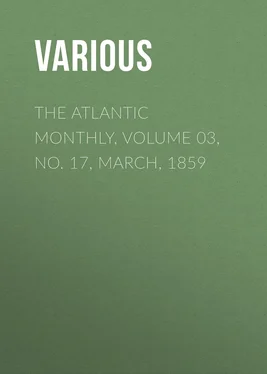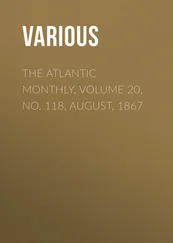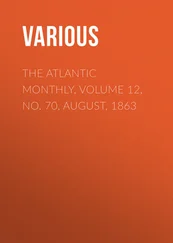Various - The Atlantic Monthly, Volume 03, No. 17, March, 1859
Здесь есть возможность читать онлайн «Various - The Atlantic Monthly, Volume 03, No. 17, March, 1859» — ознакомительный отрывок электронной книги совершенно бесплатно, а после прочтения отрывка купить полную версию. В некоторых случаях можно слушать аудио, скачать через торрент в формате fb2 и присутствует краткое содержание. Жанр: foreign_antique, periodic, foreign_edu, на английском языке. Описание произведения, (предисловие) а так же отзывы посетителей доступны на портале библиотеки ЛибКат.
- Название:The Atlantic Monthly, Volume 03, No. 17, March, 1859
- Автор:
- Жанр:
- Год:неизвестен
- ISBN:нет данных
- Рейтинг книги:5 / 5. Голосов: 1
-
Избранное:Добавить в избранное
- Отзывы:
-
Ваша оценка:
- 100
- 1
- 2
- 3
- 4
- 5
The Atlantic Monthly, Volume 03, No. 17, March, 1859: краткое содержание, описание и аннотация
Предлагаем к чтению аннотацию, описание, краткое содержание или предисловие (зависит от того, что написал сам автор книги «The Atlantic Monthly, Volume 03, No. 17, March, 1859»). Если вы не нашли необходимую информацию о книге — напишите в комментариях, мы постараемся отыскать её.
The Atlantic Monthly, Volume 03, No. 17, March, 1859 — читать онлайн ознакомительный отрывок
Ниже представлен текст книги, разбитый по страницам. Система сохранения места последней прочитанной страницы, позволяет с удобством читать онлайн бесплатно книгу «The Atlantic Monthly, Volume 03, No. 17, March, 1859», без необходимости каждый раз заново искать на чём Вы остановились. Поставьте закладку, и сможете в любой момент перейти на страницу, на которой закончили чтение.
Интервал:
Закладка:
Any attempt to reproduce the effect of those groups in words can hardly fail to fall equally short of the mark; but we will tell our readers what they are, and endeavor to give some notion of their purpose and spirit.
The first shows the Creation of Woman;—we have seen before why she is made thus prominent in the Dance. The composition is crowded with the denizens of the earth, the air, and the water; the sun, the moon, and the stars all appear; the four winds of heaven issue from the laboring cheeks of figures that impersonate them. The Creator, in the form of an aged man in royal robes, and wearing the imperial crown, lifts Eve bodily from the side of the sleeping Adam.
The second represents the Temptation. Eve reclines upon the ground, and shows Adam the fruit which she has plucked. Adam stands grasping the tree with his left hand, and raises his right to gather for himself. The serpent, who looks down upon Eve, has the face and body of a woman. The forms in this group are fine; Adam's is remarkable for its symmetry and grace; but Eve's face is ignoble. Indeed, Holbein, like Rembrandt, seems to have been incapable of an idea of female beauty.
In the third we see the Expulsion from Paradise; and here the Dance begins. Our guilty parents fly before the flaming sword,—poor Eve cowering, and her hair streaming in a wavy flood upon the wind; and before them, but unseen, Death leaps and curvets to the sound of a vielle or rote,—an old musical stringed instrument,—which he has hung about his neck. His glee, as he leads forth his victims into the valley where his shadow lies, is perceptible in every line of his angular anatomy; his very toes curl up like those of a baby in its merriment.
In the fourth, Adam has begun to till the ground. The pioneer of his race, he is uprooting a huge tree, all unconscious that another figure is laboring at his side. It is not Eve, who sits in the background with her first-born at her breast and her distaff by her side,—but Death, who, with a huge lever in his bony gripe, goes at his work with a fierce energy which puts the efforts of his muscular companion to shame. The people of Holbein's day not only saw in this subject the beginning of that toil which is the lot of humankind, but, as they looked upon the common ancestors of all men, laboring for the means of life, they asked, in the words of an old distich,—
"When Adam delved and Eve span,
Where was then the gentleman?"
The fifth composition seems to represent a general rejoicing over the Triumph of Death. It shows a churchyard and porch filled with skeletons, who blow trumpets of all sorts and sizes; one beats frantically upon a pair of kettle-drums, and another, wearing a woman's nightcap, with a broad frill border, plays the hurdy-gurdy.
In the sixth, a Pope, the highest earthly potentate, is in the act of crowning an Emperor, who kneels to kiss his toe. But the successor of St. Peter does not see, as he sits upon his throne, giving authority and sanction to the ruler of an empire, that a skeleton leans from behind that throne, and grins in his face, and that another in a cardinal's hat mingles with the throng before him.
The seventh is one of the finest of the series. An Emperor is enthroned, with his courtiers round him. He is threatening one with his sword for some act of injustice from which a poor peasant who kneels before him has suffered. But, unseen by all, a skeleton bestrides the shoulders of the monarch and lays his hand upon his very crown. There can be no doubt that Shakspeare had this subject in his mind when he wrote that fine passage in "King Richard the Second,"—
"Within the hollow crown
That rounds the mortal temples of a king
Keeps Death his court; and there the antic sits,
Scoffing his state and grinning at his pomp;
Allowing him a breath, a little scene
To monarchize, be feared, and kill with looks;
Infusing him with self and vain conceit,
As if this flesh which walls about our life
Were brass impregnable; and humored thus,
Comes at the last, and with a little pin
Bores through his castle wall, and—farewell, King!"
In the eighth we see a King (it is unmistakably Francis I.) dining under a canopy, and served by a splendid retinue. He stretches out his hand to receive a wine-cup; for he does not see that Death is filling it.
A Cardinal appears in the ninth, selling an indulgence for a heavy bribe; and we all rejoice to see that Death has laid hands upon his hat,—the symbol of his rank,—and is about to tear it from his head.
In the tenth, an Empress, passing through her palace-yard, attended by her ladies, is led by the favorite on whom she leans, and who she does not see is Death, into an open grave.
Death, in the next, has assumed the guise of a Court Fool, and has seized a Queen at the very gate of her palace. She recognizes him, and struggles, shrieking, to free herself from his grasp; but in vain. With a grin of fierce delight, he lifts up his hour-glass before her, and, in spite of her resistance and that of a gentleman who attends her, is about to bear her off. Every line of this composition is instinct with life.
In the twelfth, Death carries off a Bishop from his flock.
In the thirteenth, an Elector of the Empire, surrounded by his retinue, is approached by a poor woman, who begs his aid in behalf of herself and her child; he repulses her scornfully; for he does not see that Death, the avenger of the oppressed poor, and who is here crowned with oak-leaves, has laid his gripe upon him. Holbein has put such an expression of power into the arm and of wrath into the face of this skeleton, that we expect to see his victim haled off into the air before our very eyes.
The Abbot and the Abbess are the subjects of the next two cuts. In the former, Death has assumed the mitre and the crosier of his victim, and drags him off with such an expression of fun and burlesque pomp as we sometimes see in the face of a mischievous boy who mocks his betters. In the companion group his look is that of a demon; and with his head fantastically dressed, he drags the Abbess off by the scapulary which hangs from her neck.
A Nobleman and a Canon are his prey in the sixteenth and seventeenth groups. We lack space to describe any but the most remarkable with particularity.
The satire of the next three is levelled against the Lawyers, who were held in such little respect in Bâle. They show a Judge who takes a bribe from a rich to wrong a poor suitor, and a Counsellor and an Advocate who lend their talents to wealthy clients, but turn their backs upon the poor victims of "the oppressor's wrong." In one, a demon is blowing suggestions into the Counsellor's ear from a pair of bellows, which he has doubtless used elsewhere for other purposes; in all, Death stands ready to avenge the poor.
In the twenty-first, a Preacher addresses a Congregation, whose interested attention the painter has portrayed with great skill, knowledge of character, and consequent variety and truth of expression. Behind the Preacher stands Death, and, with a kind of grotesque practical pun, holds the jaw of a skeleton over his head, as far more eloquent than his own.
A Priest and a Mendicant Friar are the subjects of the twenty-second and twenty-third.
The twenty-fourth is of peculiar interest. In it we see a youthful Nun, who, it is clear, has taken her vows too hastily, kneeling before the oratory in her cell. But her heart is not in her devotions; for the lover whom she abandoned has made his way into the apartment, and sits on her bed singing to his lute. Her hands are clasped, not in prayer, but in an agony of love and apprehension. She turns from the crucifix to gaze at him; and we see how the interview will end: for an aged female attendant, in coif and scapulary, leans over to extinguish the candles. We see, too, what its consequence will be; for that attendant is Death.
Читать дальшеИнтервал:
Закладка:
Похожие книги на «The Atlantic Monthly, Volume 03, No. 17, March, 1859»
Представляем Вашему вниманию похожие книги на «The Atlantic Monthly, Volume 03, No. 17, March, 1859» списком для выбора. Мы отобрали схожую по названию и смыслу литературу в надежде предоставить читателям больше вариантов отыскать новые, интересные, ещё непрочитанные произведения.
Обсуждение, отзывы о книге «The Atlantic Monthly, Volume 03, No. 17, March, 1859» и просто собственные мнения читателей. Оставьте ваши комментарии, напишите, что Вы думаете о произведении, его смысле или главных героях. Укажите что конкретно понравилось, а что нет, и почему Вы так считаете.












